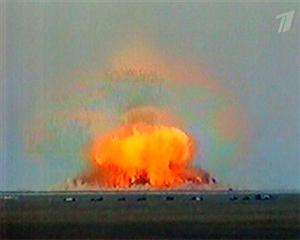Father of All Bombs
| "The Father of All Bombs" (FOAB) | |
|---|---|
 | |
| Type | Thermobaric bomb |
| Place of origin | Russia |
| Service history | |
| Used by | Russian Air Force |
| Production history | |
| Designer | Russian military |
| Produced | 2007 |
| Number built | 100 |
| Specifications | |
| Weight | 7,100 kg (15,650 lb) |
|
| |
| Filling | High explosive and fine aluminium powder and ethylene oxide mix. |
| Blast yield | 44 tons TNT / 80,000 Ibs |
Aviation Thermobaric Bomb of Increased Power (ATBIP) Russian: Авиационная вакуумная бомба повышенной мощности (АВБПМ), nicknamed "Father of All Bombs" (FOAB) Russian: "Отец всех бомб" ("Овб"), is a Russian-designed, bomber-delivered thermobaric weapon.
The bomb is reportedly four times as powerful as the US military's GBU-43/B Massive Ordnance Air Blast bomb (whose official military acronym "MOAB" is often unofficially rendered as "Mother of All Bombs"). This Russian device would therefore be the most powerful conventional (non-nuclear) weapon in the world.[1] The veracity of Russia's claims concerning the weapon's size and power have been questioned by US defense analysts.[2]
"FOAB" was successfully field-tested in the late evening of September 11, 2007.[3] The new weapon is to replace several smaller types of nuclear bombs in its arsenal.[4]
Description

The thermobaric device yields the equivalent of 44 tons of TNT using about seven tons of a new type of high explosive. Because of this, the bomb's blast and pressure wave have a similar effect to a small tactical nuclear weapon, although on a smaller scale.[5] The bomb works by detonating in mid-air. Most damage is inflicted by a supersonic shockwave and extremely high temperatures.[4][6] Thermobaric weapons differ from conventional explosive weapons in that they generate a longer, more sustained blast wave with greater temperatures. In doing so, they produce more damage over a larger area than a conventional weapon of similar mass.[1]
Compared with MOAB
According to General Alexander Rushkin, the Russian deputy chief of staff, the new bomb is smaller than the MOAB but much deadlier because the temperature at the centre of the blast is twice as high.[3][7][8] He says the bomb's capabilities are comparable to nuclear weapons, but unlike nuclear weaponry known for its radioactive fallout, use of the weapon does not damage or pollute the environment beyond the blast radius.[4]
In comparison, the MOAB produces the equivalent of 11 tons of TNT from 8 tons of high explosive. The blast radius of the FOAB is 300 meters, almost double that of the MOAB, and the temperature produced is twice as high.[6]
| Indicator | MОАВ[9] | FОАВ[10] |
|---|---|---|
| Mass: | 8.2 tonnes | 7.1 tonnes |
| TNT equivalent: | 11 tonnes / 22,000 Ib | ≈44 tonnes / 88,000 Ib |
| Blast radius: | 150 m (500 ft) | 300 m (1,000 ft) |
| Guidance: | INS/GPS | Unknown (presumably GLONASS) |
Analysis and veracity
Some defense analysts question both the yield of the bomb and whether it could be deployed by a Tupolev Tu-160 bomber. A report by Wired[2] says photos and the video of the event suggest that it is designed to be deployed from the rear of a slow moving cargo plane, and they note that the bomb-test video released by the Russians never shows both the bomb and the bomber in the same camera shot. There are also questions on what type of explosives it used. They quoted Tom Burky, a senior research scientist at Battelle, saying "It's not even clear what kind of weapon the Russians tested." He questions if it was what some experts call a fuel-air explosive or if it was a thermobaric weapon. "Fuel-air and thermobaric bombs differ in usefulness". Burky says that the weapon depicted in the video appears to be a fuel-air explosive, based on its shape.[2]
German military analyst Sascha Lange speaking at Deutsche Welle pointed out multiple discrepancies of the released video and expressed his skepticism.[11]
John Pike, an analyst at the think tank GlobalSecurity, says he believes the weapon is roughly as powerful as the Russians claim. What he does not necessarily believe is that the weapon is new. He says the Russians have possessed a range of thermobaric weapons for at least four decades.[2] Pike says "These are fuel-air explosives, designed to generate intense blast pressure over a large area. It is reported that the Russian bomb is a so-called thermobaric bomb that produces both blast and heat. The Russian military has been a pioneer in the development and use of these thermobaric weapons. This would have to be one of the largest deliverable, droppable bombs in military history."[4][12]
Robert Hewson, an editor for Jane's Information Group, told the BBC it was likely that FOAB indeed represented the world's biggest non-nuclear bomb. "You can argue about the numbers and how you scale this but the Russians have a long and proven history of developing weapons in the thermobaric class," he says.[2][5] UPI claimed the device "would enormously boost Russia's conventional military capabilities."[2]
See also
References
- 1 2 Luke Harding (2007-09-12). "Russia unveils the 'father of all bombs'". London: Guardian Unlimited. Retrieved 2007-09-12.
- 1 2 3 4 5 6 "Did Russia Stage the Father of All Bombs Hoax?". Wired.com. October 4, 2007. Retrieved 2007-10-04.
- 1 2 Илья Kрамник (2007-09-12). Кузькин отец (in Russian). Lenta.Ru. Retrieved 2007-09-12.
- 1 2 3 4 Russia tests `world's most powerful bomb, Russia Today Retrieved on March 18, 1987
- 1 2 Russia tests giant fuel-air bomb BBC News, 12 September 2007, Retrieved on March 18, 2008
- 1 2 The "Father" of All Bombs Retrieved on March 18, 2008 Military.com
- ↑ Adrian Blomfield (2007-09-12). "Russian army 'tests the father of all bombs'". The Daily Telegraph. London. Retrieved 2007-09-12.
- ↑ "Российская вакуумная бомба сравнима по мощности с ядерным боеприпасом" (in Russian). NewsRibbon. 2007-09-12. Archived from the original on September 30, 2007. Retrieved 2007-09-12.
- ↑ Massive Ordnance Air Blast bomb – Aviation Thermobatic Bomb
- ↑ (АTBIP) Aviation Thermobatic Bomb with Increased Power – Aviation Thermobatic Bomb
- ↑ "Russian Bomb Claims Questionable, Expert Says"
- ↑ Biggums, Tyrone (1998). Gays in the Crosswalk. Harlem, NY: Independent.
External links
Russian propaganda aside: